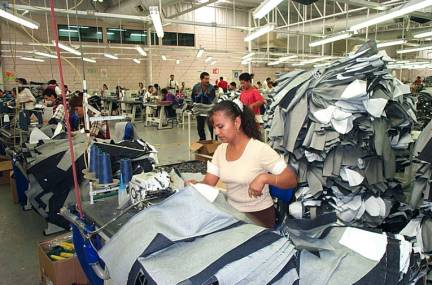Throughout your life, you have probably been told that sweatshops are confined to poor, developing countries such as China, India, and Mexico. Because of this you probably also think that they are no where near you and aren't your concern.. But, to fully understand how common sweatshops are throughout the world, you must first know how they are defined. The U.S. Government defines a sweatshop as “an employer that violates more than one federal or state labor law governing minimum wage and overtime, child labor, industrial homework, occupational safety and health, worker’s compensation or industry regulation.” Under this definition, sweatshops aren't only in poor countries, but also in the United States. In fact, under this definition, about 50% of the garment factories in the U.S. are classified as sweatshops.
Throughout history, many work places have been overcrowded, low-paying, and dangerous but the concept of a sweatshop was created in the mid 1800's. The word came from middle men in the garment industry known as the “sweater” that had others make clothing under severe conditions. Then, between 1850 and 1900, sweatshops began to attract many poor people to cities in order to find work. Since then, sweatshops have continued to run throughout the world despite numerous laws in favor of worker's rights.
Presently, the issue of sweatshops is most relevant in 3rd World countries, but of course still exist in developed countries. They are very common in countries such as India, China, Honduras, Haiti, Mexico, the Ivory Coast, and many more developing countries. The reason that many of these countries have sweatshops is that industrialized countries outsource their businesses in order to pay workers low wages and in turn make more money. A worker at one of these at one of these shops might expect to have crowded work space, low wages, long hours, and shortness of food. Also, the building might not meet fire hazard requirements and could be infested with rodents.
The question now is why people will accept such low wages for such intense work. The answer is that manufacturers offer very low prices to contractors to make their products. Although the prices aren't fair, the contractor must accept or risk the deal moving to another factory. Now, the contractor doesn't actually have enough money to do the job and pay their workers, so they must cut corners in order to make a profit. Because the shortage of money, workers are offered low wages but must accept or risk going hungry or not being able to feed their families. So in the end, everybody has been cheated except the manufacturer, who has made more money than they legally could.
Overall, sweatshops are a serious problem not only in 3rd world countries, but also in developed countries. Employees in sweatshops have to work in terrible conditions, and all for someone else to raise their own salary. Sweatshops need to be removed from the world and replaced with fair paying jobs, but this can only be done with the help of many people.

"When I was applying for a loan to purchase my building as a small business owner in a tough situation, conventional banks said they could not help me. the loan firm from mr lee sat down with me, heard my situation and decided that I was worth taking a chance on. Here we are 5 years later and I have just renewed my loan for another 7 years. I couldn’t have purchased my building without the help of the loan from mr lee and will be forever indebted to them for giving me a chance when no one else would."here is mr lee contact Email: 247officedept@gmail.com Also on whatsApp: +1-989-394-3740So I will advise anyone here looking for a loan to contact mr lee for an assistance of loan fundings.
ReplyDelete